RIGHT TURN ONLY!!
The Rokuro Okajima Raising Project
by Carlo Santos,

The hardest part of any convention, I find, is always the part where I have to go back to normal life. Surrounded by normal people, working at a normal job, making a normal salary.
... Actually, it makes me really thankful that I don't work full-time in "the anime industry."
BLACK LAGOON
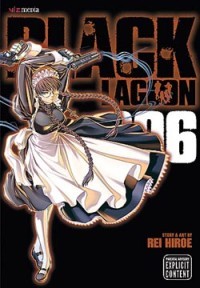
Vol. 6
(by Rei Hiroe, Viz Media, $12.99)
FROM THE BACK COVER:
"Lock 'n' load with the baddest group of mercenaries ever to hit the high seas of Southeast Asia! Aboard their World War II torpedo boat, the Black Lagoon, Dutch the Boss, Benny the Mechanic, Revy Two Hand, and Rock, the salaryman from Japan, deliver anything, anywhere. In the dangerous underworld of the Russian Mafia, Chinese triads, Colombian drug cartels, crazed assassins, and ruthless mercenaries, it's hard to know who to trust. But if you've got a delivery to make, and you don't mind a little property damage along the way, you can count on the crew of the Black Lagoon!
After their trip to Japan, the crew of the Black Lagoon winds down back in Roanapur. The R&R doesn't last long—Jane, a counterfeiter on the run from Florida-based gangsters, seeks refuge with the Church of Violence, kicking off a hot pursuit involving some of Roanapur's more colorful guns-for-hire. Later, half a world away in Venezuela, a bomb blast shatters what calm Garcia and Roberta have managed to restore in their lives. Garcia tries to sway Roberta from seeking vengeance, but the 'Bloodhound of Florencia' will have justice, and woe to anyone who gets in her way!"
EVIDENCE FOR:
It's almost as if the main arc of this volume was written on a dare: how long can Rei Hiroe sustain a series of chases and gunfights before finally giving in to the demands of plot? Well, how does 130 pages of pure action sound? No storyline digs into the essence of Black Lagoon quite like "Greenback Jane," which jumps from one explosive set-piece to the next with the urgency of a rabid bulldog. Plus it's not just the dynamic angles, stylish moves and over-the-top destruction that make it so thrilling; the series' colorful characters also provide much of its perpetual energy. Whether it's new creations like a gunslinging cowboy, a tubby pyromaniac, and a chainsaw-wielding goth girl, or the return of old favorites like "Chinglish gal" Shenhua and "nun with gun" Sister Eda, there seems to be no end to the memorable personalities that Hiroe is able to draw up. Speaking of old favorites, we can't forget about the psychotic killer maid that stars in the last couple of chapters; even in the introductory stages of a story, no one takes over a scene quite like Roberta. Let the bullets fly!
EVIDENCE AGAINST:
Writers and artists, take note: coming up with storylines based on a dare is probably not the best idea for keeping the reader engaged. The impetus behind "Greenback Jane" may seem exciting at first, but by about page 80, all the nonstop fighting starts to get pretty boring. And it's not like there are any clever twists or changes of allegiance to keep it interesting: the sequence basically comes down to having Shootout 1 at Location A, Shootout 2 at Location B, Shootout 3 ... and so on, interspersed with the occasional chase scene so they can shift locations. Things get so drawn-out and over-the-top that the action scenes stop even making any sense and people seem to magically teleport to wherever it is they need to be for the next slugfest. The psychotic killer maid story also introduces confusion in its own way, setting up the premise in a rushed manner and then just kind of forcing its way into the part where Roberta goes nuts and starts trying to kill everyone. Yes, we love action, but we love understanding what's going on too.
FINAL VERDICT:
Admittedly, this one drops the ball on clear storytelling and providing anything of substance. But when the action is as intense and nonstop as this, you can still walk away with a B.
MAID SAMA!
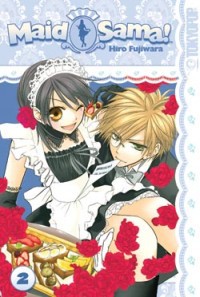
Vol. 2
(by Hiro Fujiwara, Tokyopop, $10.99)
FROM THE BACK COVER:
"Misaki's troubles with Usui are far from over! His apparent feelings for Misaki end up confusing her just when she's trying to clear her head. To make matters worse, two hot guys from a highly ranked prep school show up, causing more distraction than Misaki needs! And with the school sports festival just around the corner, Misaki begins to wonder if having someone around might not be so bad after all..."
EVIDENCE FOR:
Was the wacky dual-life concept behind Maid Sama! just a one-volume wonder? Not if Volume 2 has anything to say about it—this round of comedic misadventures proves that the series continues to be way more fun than it probably deserves to be. As always, the elements seem to teeter on the edge of cliché—a brash female lead, an enigmatic love interest, lots and lots of maid outfits, a rival private school—yet the sheer overachieving energy of Misaki's character, coupled with Usui's supercool style, results in a delightful chemistry that transcends the average shoujo romance. The multi-chapter arc involving elite institution Miyabigaoka High School also adds depth to the story, bringing in ruthless rivals and conspiratorial schemes that push Misaki's emotional capacity to the brink. Meanwhile, there are also plenty of laughs to be had, especially in the riotous "all the maids dress up as guys" chapter that spoofs the Butler Café subculture. Best of all, the well-spaced panel layouts and distinctive characters make this one of the more readable offerings in the genre—and if you can tell the story clearly, you've already won half the battle.
EVIDENCE AGAINST:
It's easy to get caught up in the bubbly energy of this series, but a bog-standard school comedy is still a bog-standard school comedy. This means having to go through the usual run of clichés like a sports festival. Really, is there anything new that can be said about a sports festival? Misaki runs in a bunch of races and she either wins or she doesn't. This is not exactly the most compelling material. Even storylines that seem to deliver the goods end up falling victim to lazy storytelling shortcuts, like the entire Miyabigaoka student council being made up of sneering evil bishonen, and how that arc in general ends up dragging on too long because of Misaki's negotiations with the school. Also, it's starting to become pretty obvious that Usui is way too overpowered as a character and ends up coming out of nowhere to save Misaki every single time. (Not even the tongue-in-cheek self-referential jokes about this phenomenon can save it now.) On the artistic side, Fujiwara still uses too many screentones and crams the panels too small a couple of times—just a sign that bad shoujo habits die hard.
FINAL VERDICT:
Oh, we can nitpick faults about Maid Sama! all day. But the fact remains: great characters and a great sense of humor will always win out in the end, granting this volume a solid B so far.
MOMOGUMI PLUS SENKI
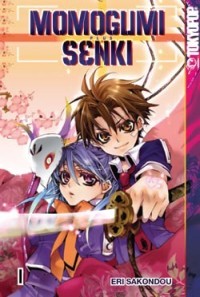
Vol. 1
(by Eri Sakondo, Tokyopop, $10.99)
FROM THE BACK COVER:
"After transferring to a new school, Yuuki, a disaster-attracting young student, is told that he is actually the reincarnation of Momotaro from Japanese folklore. What's worse, he was cursed by demons in his previous life! And if he doesn't break the curse, he will die on the day he turns eighteen. Luckily for Yuuki he won't have to battle these demons alone—his three mystical minions, Yukishiro, Masahiko and Sawa will be there to instruct and protect him every step of the way!"
EVIDENCE FOR:
There are essentially a couple of paths you can take when it comes to modern-day stories based on ancient folk tales. One is to take that initial idea, let it run its course, and eventually fizzle out. The other is to take that idea ... and build on it until everything goes nuts! The sparks of creativity fly constantly in Momogumi Plus Senki, which doesn't just bring out Yuuki and friends as reincarnations of famous folkloric characters, but decides to apply appropriate roles to all the other students in school as well. The demons in the Momotaro story, grandma and grandpa, even characters from other related tales and legends—they're all here, recast as schoolkids, which makes for endless comedic possibilities. Heck, they even got Momotaro's sword! But folktale parody and witty dialogue aren't the only highlights of this series—the action-adventure element shines as well, with sharp lines and sweeping curves helping to accentuate the grandeur of battle. While Yuuki doesn't necessarily beat the bad guys into submission, he always finds the clever way to defeat them, which turns out to be a lot more fun than pure physical battle anyway.
EVIDENCE AGAINST:
It may enough for some to see famous characters of lore being remixed into a modern-day story—after all, some fantasy writers get away with this concept wholesale—but the resulting story isn't quite as impressive. It is, after all, one of those countdown-timer-based slugfests (beat all the demons before you turn eighteen!) and never aspires to anything more complex. Yuuki just goes around beating demons, adding allies to his party, and if any clever story twists are in store, well, they're clearly not happening in this volume. It also doesn't help that the characters' personalities are poorly sketched out; Eri Sakondo seems content to apply a few wacky traits to everyone and then let the story go on autopilot. Thus we end up with rather uninteresting supporting characters like Yukishiro, who nosebleeds everytime she sees Yuuki, and Sawa, who just kind of yells and gets into fights a lot. Honestly, the original dog, bird and monkey were more fun than this. The fight scenes aren't perfect either, often getting cluttered with scenic details and tricky angles that do more to confuse than to excite.
FINAL VERDICT:
Pretty ordinary for an adventure story, but it does make good use of the reincarnated-character concept and applies some good touches of humor, so that's a C+ right there.
NEON GENESIS EVANGELION: THE SHINJI IKARI RAISING PROJECT
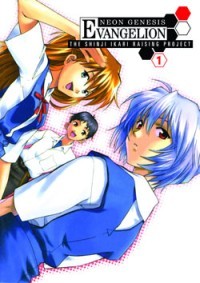
Vol. 1
(by Osamu Takahashi, original concept by Gainax/khara, Dark Horse, $9.95)
FROM THE BACK COVER:
"Stunning, hotheaded Asuka Langley Soryu has been friends with Shinji Ikari since they were little. And she always sort of assumed they'd stay together—until the day the beautiful, brilliant Rei Ayanami showed up in class! When Shinji starts to get curious about Rei, Asuka needs to figure out if she wants to be just friends with Shinji, or something more. But why are so many people keeping an eye on these relationship—people like homeroom teacher Misato, school nurse Ritsuko, and Shinji's mother—NERV's chief scientist, Yui Ikari...?"
EVIDENCE FOR:
What is there to say about Evangelion that hasn't already been said? How about this: The Shinji Ikari Raising Project is probably the best adaptation (so far) of the series' high school romantic comedy alternate universe. The character designs are accurate enough not to be distracting (hello, Angelic Days), sometimes even displaying shades of emotion that never could have happened in the original—Rei's smile at the end of Chapter 3, Asuka's blushing cheeks of shyness at the summer festival, even a moment of hesitation from Gendo. And rather than try to shoehorn the mecha elements into the story before it's necessary, Osamu Takahashi lets the high school romance aspect develop for as long as it takes to feel comfortable with the situation. The result? A much more believable, organic take on the lighter side of Eva, with a number of genuinely heartwarming moments and a gentle smattering of comedy. And when the moment comes at last for Shinji to do the piloting that must be done, he doesn't run away. He doesn't run away. He doesn't run away...
EVIDENCE AGAINST:
All right, here's what I have to say about Evangelion that hasn't already been said: as a self-confessed Asuka fan, the entire first half of this volume makes me grit my teeth. The biased attempts at pairing Shinji with Rei never feel convincing, and Takahashi even has to trot out the cliché of clichés—a beach chapter—in an attempt to bring that couple together. Haven't we seen enough of Eva girls in swimsuits over the last 15 years? Only when the story starts to lean towards Shinji/Asuka does the romantic aspect feel like it's working, and even that has to rely on the rusty old standby of childhood friends. That's the problem with playing up the alternate-universe version of Evangelion: no matter how well you execute the high school romance formula, it's still a high school romance formula. That also means bringing in side characters who are annoying as hell and keep commenting on how hot the girls are—yes, Toji Suzuhara, that means you and your ridiculous Kansai accent.
FINAL VERDICT:
A pleasant enough romp through the sweet side of the Eva universe, but the very nature of the project causes some inherent flaws that lead to a B-.
WAQWAQ

Vol. 1
(by Ryu Fujisaki, Viz Media, $7.99)
FROM THE BACK COVER:
"Living in constant fear of attack from machines, mankind depends on the cyborg cops known as the Guardians to keep them from harm as they await the arrival of the Kami, a godlike savior with mythical red blood who can grant Only One Wish to one person. Now Shio, son of a Guardian, thinks he's found the Kami—and all the Guardians are at war to get that wish!
Shio is forced by the tragedy of the machine war to team up with a mysterious girl from another world whose blood is the color red, just like the prophecies proclaim. Is the girl the human race's Last Hope for survival in a world overrun by metal?"
EVIDENCE FOR:
In the world of Shonen Jump, where they make up trippy new fantasy and sci-fi universes every week, it takes a certain talent to stand out—and fortunately Ryu Fujisaki has it. The creatures and environments of Waqwaq all have a certain sheen to them, a distinctive blend of technology, biomechanics, and post-apocaplytic wear and tear that won't be confused with anything else. Fujisaki also packs in a number of high-flying action scenes, which become especially thrilling once Shio figures out his Guardian powers and how to fight with them (that last page is a real killer). But visual flash and Fighting Spirit are to be found everywhere in boys' comics these days, and what really sets this series apart is how it stops to think every now and then—contemplating the meaning of the war between man and machine, and even concepts of theology (they use the word "Kami" in this translation, but we all know what they're getting at), as Shio tries to understand the world around him. The secret, perhaps, is realizing that this world isn't the only one...
EVIDENCE AGAINST:
Visual flash and Fighting Spirit sounds about right, because after the glow of Fujisaki's creative artistry wears off, it's hard to find anything else that's special about this first volume. Shio inherits some amazing technomagical fighting powers (which sounds like the plot of about 3700 other series), discovers a mysterious girl from another world (which sounds like the plot of about 4200 other series), and most likely he'll be battling a number of increasingly tough villains (which sounds like the plot of ... well, everything). Heck, he encounters two of them in this volume already, and it's hard to see what sets them apart besides a couple of variations in character design. Yes, it's true that Fujisaki has created a unique aesthetic for this universe, but he kind of forgot about differentiating the inhabitants within that universe. It's also hard to find any traces of originality when the dialogue is peppered with lines like "the greatest power in the world shall be mine" and "you don't understand my pain." Y'know, maybe you don't understand my pain of having to read a hotchpotch of generic fantasy-adventure tropes.
FINAL VERDICT:
Creative character and monster designs only go so far, and ultimately this predictable hack-and-slash comes out with a C.

DYSTOPIA
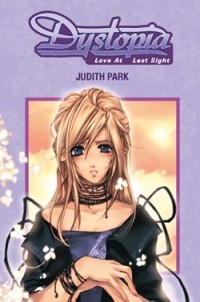
(by Judith Park, Yen Press, $10.99)
FROM THE BACK COVER:
"Dionne is best friends with her older brother, Lyon. Even though things don't always run smoothly in their family, nothing in the world can shake them—as long as they can rely on one another! But one day, an unexpected misfortune brings their seemingly bright world into disarry ... and Dionne fears she may never be understood and loved again. When her parents offer their shocking solution, her emotions only become more tangled. Will Dionne ever be able to recover from this tragedy?"
EVIDENCE FOR:
It takes real guts to produce a work of such raw emotion as Dystopia. Especially in German! In a single one-shot volume, Judith Park manages to transcend the entire dramatic spectrum, laying out the peaks and valleys of adolescence for all to see. There are, of course, classic standbys like first love and unbreakable friendship—the first half is so heart-meltingly sweet that even the most stone-faced reader will soften up—but the later chapters also explore more complex feelings like loss, heartbreak and anger. As a study on how to face the greatest tragedy of one's life, this story is a powerful cathartic experience, presenting emotional truths that may have been forgotten in today's detached, ironic world. It doesn't hurt either that Park knows how to work a page, filling each panel with attractive characters and expressive gestures, and then lining things up so that the story flows effortlessly from one scene to the next. It may not be as long as the great shoujo melodramas of our time, but it still packs the same punch—a punch that hits right in the center of your heart.
EVIDENCE AGAINST:
Have any of you read that Doom fan fiction by Peter Chimaera where protagonist John Stalvern realizes that "he is the demons" and becomes a zombie? Because the integral plot twist of Dystopia is even loopier than that, turning an otherwise touching teenage melodrama into an absolute head-scratcher. The worst part is, the twist comes at a point where it's pretty much impossible to recover from it, resulting in about 40 pages of the weirdest angst ever until the story mercifully ends. Not that the ending is particularly conclusive or satisfying—like the rest of the book, it's a rushed affair, proving that single-volume works are best left to artists who really know what they're doing. Unfortunately, that's not the case here; this is one of Park's earlier works, predating Y Square by about a year. As such, the rookie mistakes are everywhere: misshapen faces, cheesy dialogue, enough screentone effects to put an eye out, and yes, story moments that may have seemed like a good idea at the time but just come out really awkward and weird. And then Dionne was a zombie.
FINAL VERDICT:
This definitely could have used better artistic polish and an editorial reworking, but it's still impressive to see Park's command of emotion and visual layout at such a young age—especially when other creators spend their entire lives trying to master it.

She's the creator of one of the most successful shoujo series in history. So why aren't US publishers all jumping over Yōko Kamio's Cat Street? I don't have the answer to that question, but Carolyn Urban makes a very good case for why this is one series that deserves to be licensed in her review below.
And for the next topic: Titles that never should have been licensed! Which is it, folks? Tell me about the manga that should have just stayed on Japanese shelves ...
CAT STREET

(by Yōko Kamio, Shueisha, ¥410 ea.)
Hana Yori Dango (Boys Over Flowers) is 37 volumes of manga, a full anime series, and one of the most popular live-action dramas in Japan. So what's next? Cat Street. <minor spoilers ahead!>
Yōko Kamio's next title has a subtle, more realistic plot: Betrayed, former child actress Aoyama Keito went emo in her room for 7 years. What about school, you ask? Why bother? She always missed it for her acting gigs to begin with and that paid enough. Then she gets introduced to a free school called El Liston, a place to help "Stray Cats" just like her. The idea seems stupid at first, until she meets some interesting people—a Lolita, a geek, and a soccer ace—that encourage her live her life just as they are trying to do.
Cat Street is about getting back on your feet, which is something we all must learn eventually. The character designs are a big improvement (being up-to-date with a better fashion sense can help) with each character seamlessly growing up as you read. Sure, the whole story's based on stereotypes, but they're developed enough and believable that it's easy to identify with them. And, come on. Name another shoujo were the main character doesn't win her first love and instead must get over it and continue the story? Even after that it demonstrates how relationships don't just magically work out after overcoming some rival or whatever for opposition.
Just beware; Cat Street still gets overly-dramatic just like HYD and it's not hard to spot many other similarities between the two. Plus the ending, though still satisfying, felt rushed with random new characters coming in to inspire the last arc. But that's probably due to the fact that everyone wanted her to release the HYD "sequel." Sad, but hey, that's what we all wanted... Besides, most of what can be said against this series should be expected by returning fans anyway.
All in all, I think this would be a great addition to bookstore shelves across the States because it has something to offer to every reader. Now that Yoko's biggest series is finally finished by Viz, it would be nice to continue with her newer works. She tells a good story, and not just the long-running ones. Cat Street, for example, is only 8 volumes. It's plain to see she's not just a one-hit wonder.
Is there a hidden gem of manga you'd like to reveal to the world? Is there a piece of garbage that deserves to be bashed in public? Or is there a title that didn't get a fair grade here, and you want to set the record straight?
Now's YOUR chance to be the reviewer! Write a review of about 300-400 words (a little more or less is fine) and include:
- your name.
- Title of manga (and volume no., if applicable)
- Author/Artist
- Publisher
- Briefly describe the story, then explain why this manga is great, terrible, or in between. Be objective, but also be entertaining.
Then send it in to rtoreaders (at) gmail (dot) com (plain text format preferred). One review will be selected out of all the submissions and will be published in the next column. All types of manga and manga-inspired comickry are accepted, from past and present, from Japan and beyond—what matters is that it's the Reader's Choice! NOTE: Submissions may be edited for formatting and grammar.
discuss this in the forum (12 posts) |
this article has been modified since it was originally posted; see change history